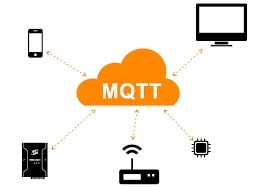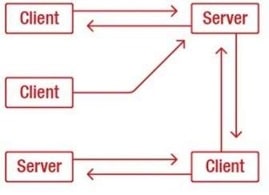Home »
IoT (Internet of Things) Tutorial
IoT Application Layer Protocols: MQTT and CoAP
In this tutorial, we will learn about the IoT application layer protocols: MQTT and CoAP, and the difference between COAP and MQTT protocols.
By Shahnail Khan Last updated : September 26, 2023
In computer networks, application layer protocols are essential for facilitating communication between end-user programs. These protocols lay forth the guidelines and standards for sending messages between various systems. MQTT and CoAP are the most commonly used protocols used in deploying IoT solutions. This article explores these protocols in detail.
MQTT – Lightweight messaging protocol
MQTT, short for Message Queuing Telemetry Transport, serves as an established standard messaging protocol within the realm of the Internet of Things (IoT). It distinguishes itself as a lightweight, machine-to-machine network protocol that operates on a publish-subscribe model, offering efficient message queuing services. MQTT is critical in the IoT ecosystem as it enables devices to seamlessly share and access data over the Internet, hence holding its significance as a fundamental communication protocol for IoT applications.

Here are some key insights into MQTT:
- Lightweight and Economical: MQTT is designed with a focus on being lightweight, making it a great fit for devices with limited resources, commonly found in IoT setups. It offers less bandwidth and power, which is perfect for devices that rely on batteries.
- Publish-Subscribe System: MQTT's messaging system uses the publish-subscribe model. In simple terms, it allows devices to share information by publishing it to specific "topics," and other devices can subscribe to those topics to receive the information they need. This feature simplifies communication and helps scalability.
- MQTT is a recognised standard that is governed by the OASIS organisation. This acknowledgement indicates that a wide number of businesses and organisations support and encourage it.
- Adaptable to Various Applications: MQTT is versatile and can be used in a wide range of IoT applications, including smart sensors, wearables, industrial automation, home automation, and more. It is a top choice for a variety of IoT applications due to its versatility and adaptability.
- Abundant Learning Resources: If MQTT interests you, you may discover several materials to aid with learning and using it. IoT projects of various sizes and complexity can use these resources, which include documentation, tutorials, and open-source implementations.
CoAP – Constrained application protocol
CoAP, or Constrained Application Protocol, is a specialized internet application protocol designed to cater to the unique needs of devices with limited resources. It is designed to be used in internet devices with limited resources, including wireless sensor network nodes. CoAP's main objective is to enable communication between these resource-constrained devices and the broader Internet, which are typically employed by more capable devices. This implies that devices like sensors can successfully connect to and interact with web-based services and other internet-connected nodes.

Here are some key insights into CoAP:
- Tailored for Limited Devices: CoAP stands out as a protocol explicitly designed to cater to devices that don't have a lot of memory or processing power. This feature makes it a top pick for Internet of Things (IoT) gadgets and sensor networks.
- Handy Protocol Features: CoAP works on a model where devices can send requests and receive responses, making communication efficient. Additionally, it has built-in resource discovery, allowing devices to easily locate and communicate with one other's resources.
- Streamlined and Resource-Friendly: CoAP operates on the User Datagram Protocol (UDP), known for its efficiency. This key feature makes it stand out from other IoT protocols like HTTP and MQTT, which can be more resource-intensive.
- Versatile Application: CoAP is used in a wide variety of IoT applications, including smart homes, industrial automation, and healthcare systems. It allows devices to share data within their local network and even with the broader internet, making it an adaptable choice for various IoT setups.
Difference between COAP and MQTT protocols
Here are the differences between COAP and MQTT protocols:
| Feature | MQTT | CoAP |
| Protocol Type |
Publish-Subscribe |
Request-Response |
| Transport Protocol |
Typically uses TCP or TLS |
Typically uses UDP or DTLS |
| Message Format |
Binary |
Binary or Text (XML/JSON) |
| QoS Levels |
0 (At most once), 1 (At least once), 2 (Exactly once) |
0 (No reliability), 1 (With confirmable messages) |
| Resource Discovery |
Not a built-in feature, requires additional mechanisms |
Built-in using CoRE Link Format |
| Header Size |
Larger header size |
Smaller header size |
| Overhead |
More overhead due to MQTT headers |
Less overhead due to smaller CoAP headers |
| Messaging Patterns |
Suitable for event-driven applications |
Suitable for request-response and resource management |
| Security |
Supports authentication and authorization, but relies on the underlying transport for encryption (e.g., TLS) |
Supports security features like DTLS for encryption and CoAP security modes |
| Scalability |
Scalable for large-scale systems |
Designed for resource-constrained devices and is lightweight |
| Subscriptions |
Clients can subscribe to topics, receiving messages when published |
Clients can request specific resources |
| Error Handling |
More advanced error handling with QoS levels |
Simpler error handling with response codes |
| Caching |
Typically not used for caching responses |
Supports caching using the Max-Age option |
| Payload Size |
Can handle larger payloads |
Designed for smaller payloads |
| Interoperability |
Widely adopted in various industries |
Well-suited for IoT devices and constrained networks |
| Usage |
Often used in scenarios where guaranteed message delivery is important |
Commonly used in resource-constrained devices and applications where low overhead is crucial |
Conclusion
These protocols serve as the foundation of various networked applications, enabling devices to seamlessly share and access data over the Internet. Each protocol serves a specific purpose. These protocols are essential for the deployment of IoT solutions, enabling diverse services and functionalities.
Advertisement
Advertisement